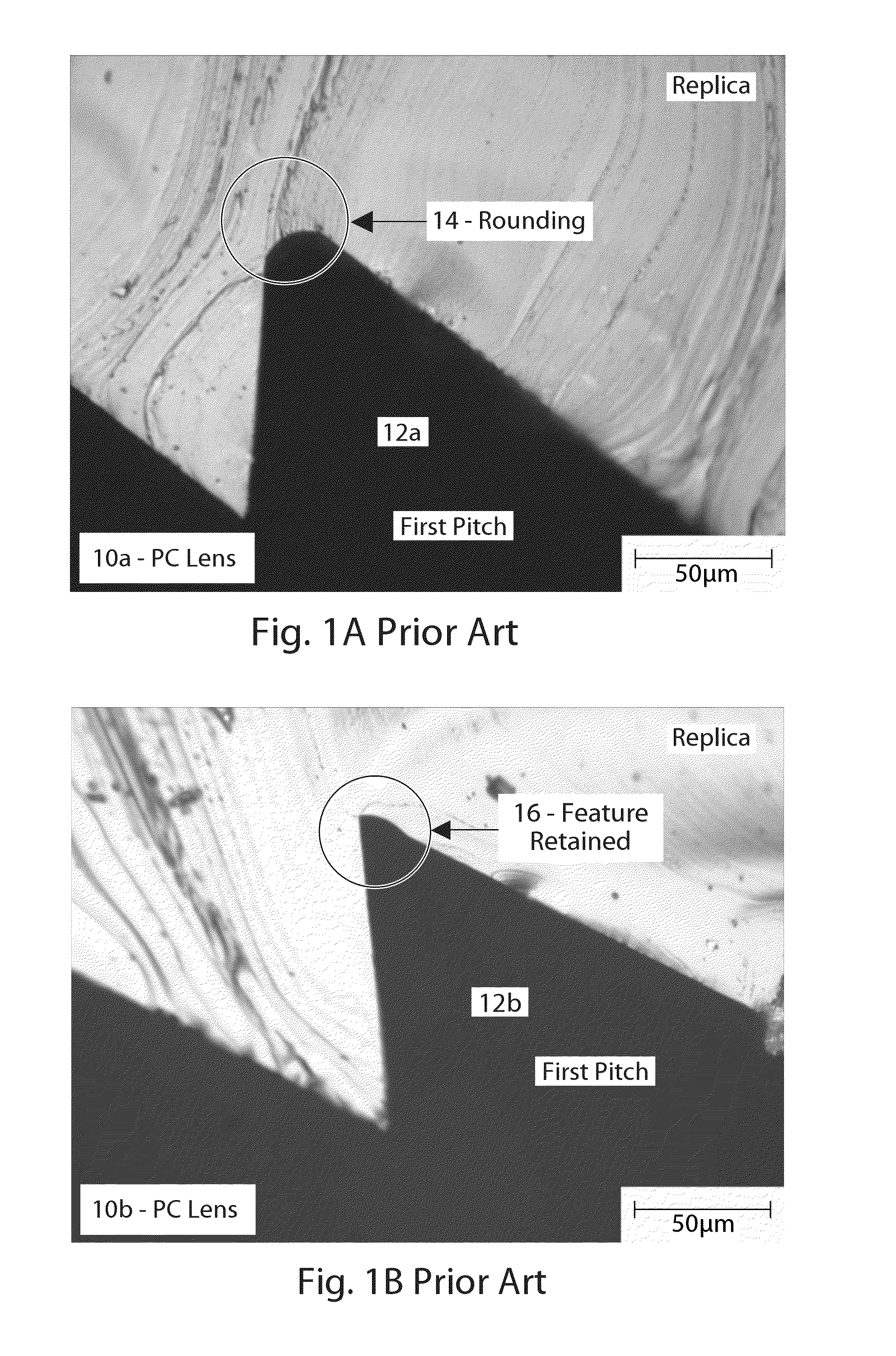Ophthalmic lens containing a fresnel surface and method for manufacturing same
a technology of fresnel and lens, which is applied in the direction of manufacturing tools, instruments, food shaping, etc., can solve the problems of inability to fill the mold with straight injection molding, inability to manufacture thin lenses with conventional injection molding, and inability to control the thermodynamics of cooling melt flow, etc., to achieve high adhesion, low adhesion, and high heat conductivity
- Summary
- Abstract
- Description
- Claims
- Application Information
AI Technical Summary
Benefits of technology
Problems solved by technology
Method used
Image
Examples
example 1
PMMA Overmolded onto Fresnel PC Lens
[0111]The typical processing conditions is listed in Table 8. Two parameters, melt temperature and mold temperature, were tested systematically (Table 9), to see their effects on microstructure filling, rounding and deformation.
TABLE 8General processing condition for PMMAParametersMelt Temperature (° F.)460Injection Speed (mm / s) 25Holding Pressure (bar)Multi steps from1000 to 150 barHolding Time (s) 9Cooling Time (s)220Mold Temperature (° F.)131
TABLE 9Test matrix for melt temperature and mold temperatureMelt Temperature (° F.)470460450440430420410 Mold111xxxxTemperature131xxxxxx(° F.)151xxxxx represents conditions being tested.
[0112]1.1 Melt Temperature Effect
[0113]The melt temperature should be set above 400° F. Otherwise, delamination will occur.
[0114]The microstructures were filled quite well, at all tested temperatures (410 to 470° F.).
[0115]The microstructure tips were rounded at edge location of Fresnel PC lens at all tested melt temperature...
example 2
TPU Overmolded onto PC Fresnel Lens
[0124]
TABLE 10Typical processing condition for TPU overmoldingParameterInjection speed (mm / s)10Injection pressure (bar)900Switch over (mm)7.5Holding Pressure (bar)Multi steps from700 to 100 barHolding Time (s)3Barrel Temperature (° F.)360Mold Temperature (° F.)150Dosage (mm)30Cooling time (s)150
[0125]The microscopic pictures of cross section of integrated TPU / Fresnel PC lens are shown in FIGS. 8A and 8B, for Fresnel teeth at different locations. FIG. 8A shows the 1st PC tooth 80a at the center of the lens with the adjacent TPU coating 82a. FIG. 8B shows the last PC tooth 80b at the edge of the lens with the adjacent TPU coating 82b. Same results are found as for PMMA / PC lens: (1) The microstructures on Fresnel lens are well filled. (2) No rounding of microstructure teeth. (3) No deformation of microstructure teeth.
[0126]The overall cosmetic aspect of coated Fresnel PC lens is good. No ghost image, or distorted image was observed. No air bubble was ...
PUM
| Property | Measurement | Unit |
|---|---|---|
| Temperature | aaaaa | aaaaa |
| Temperature | aaaaa | aaaaa |
| Temperature | aaaaa | aaaaa |
Abstract
Description
Claims
Application Information
 Login to View More
Login to View More - R&D
- Intellectual Property
- Life Sciences
- Materials
- Tech Scout
- Unparalleled Data Quality
- Higher Quality Content
- 60% Fewer Hallucinations
Browse by: Latest US Patents, China's latest patents, Technical Efficacy Thesaurus, Application Domain, Technology Topic, Popular Technical Reports.
© 2025 PatSnap. All rights reserved.Legal|Privacy policy|Modern Slavery Act Transparency Statement|Sitemap|About US| Contact US: help@patsnap.com



